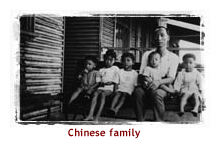Multi-racial Western Australia
 Edie
Hoy Poy grew up in Port Hedland during the 1930s in one of the small communities
of Chinese, Malays and Japanese who lived and worked in the north of Western
Australia. As an Australian-born Chinese, her father was one of many Chinese
who came to Australia prior to Federation, often as indentured labour. They
and their families remained, in spite of the White Australia Policy, and
were part of the many different races and nationalities which have always
lived in small numbers in the State. Edie
Hoy Poy grew up in Port Hedland during the 1930s in one of the small communities
of Chinese, Malays and Japanese who lived and worked in the north of Western
Australia. As an Australian-born Chinese, her father was one of many Chinese
who came to Australia prior to Federation, often as indentured labour. They
and their families remained, in spite of the White Australia Policy, and
were part of the many different races and nationalities which have always
lived in small numbers in the State.But it was not until the 1970s that Western Australia began to become truly multi-racial. The influx of migrants from all over the world made Western Australia a more racially diverse society and brought with it the benefits of multi-culturalism. |
Please note: The content on this website is made available for archival purposes and may not meet the State Library of Western Australia's current standards for web accessibility, mobile device compatibility, historical accuracy and cultural sensitivity.